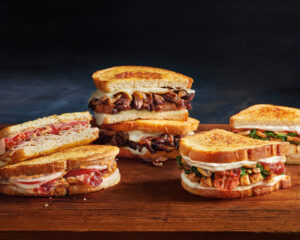
Robbie Earl, president of Virtual Dining Concepts. Photo by Rich Polk.
Robbie Earl is tired of being asked about MrBeast.
“I can’t say much because of the litigation,” said the co-founder and president of Virtual Dining Concepts (VDC). “I can say we were harmed. A lot of things will come out in court documents.”
When VDC signed the YouTuber in September 2020, it was a big deal. Virtual brands were going to help save the restaurant industry, which was reeling from Covid. Such was the hope of many at the time. And the VDC-MrBeast union, with VDC’s logistics and Mr. Beast’s galaxy of followers, seemed the rock on which the industry would rebuild.
That didn’t happen. The collaboration succeeded for a while then it cratered. The downfall began when some consumers complained that the burgers, which restaurants could license to make and sell, were poorly prepared. MrBeast, in real life Jimmy Donaldson, apologized to consumers on his feeds. Last July he sued to get out of the contract. VDC countersued, alleging $100 million in damages. It’s the kind of mess that can easily sink a company.
In April, VDC got up off the mat with the announcement of a new high-profile collaboration, this one with IHOP. The agreement makes three VDC brands — NASCAR Refuel Tenders & Burgers, MLB Ballpark Bites, and Pardon My Cheesesteak — available for delivery. Each virtual brand offers a lineup of menu items, from buffalo chicken cheesesteak to loaded fries to moderns takes on concession stand favorites found at NASCAR and MLB events. IHOP has at least one of the brands already available in more than 1,000 locations; about 500 of those have at least two.
It’s a nice win for VDC. But if it sounds familiar, it is because in 2022 one of its former competitors, NextBite, worked with IHOP on three of its own offerings — Thrilled Cheese, Tender Fix, and Super Mega Dilla. Today, NextBite is in hospice after being sold last June. Those virtual brands no longer exist.
What makes Earl sure he can succeed where NextBite failed?
“We have restructured our business model, reinforced our quality standards, and made a large push to improve our metrics,” he said. “Our goal is to build vertical revenue networks for restaurants.”
That is one tall order.
Control is king
Evert Gruyaert follows this stuff closely. He is the head of the restaurants and food-service industry group at Deloitte Consulting. He’s not sold on all the aspirations of virtual-brand companies. But he sees a narrow path that can work.
“Say you are a restaurant that is strong in breakfast or dinner and you have a physical location. It’s probably not that expensive to get one or two other people to show up for rest-of-day delivery. If you don’t want to do that with your own brand, since you are focused on specific meal occasions, it could be good to partner with a virtual-brand company to drive additional revenue,” he said.
But to do delivery well you have to be a maniac for details. That’s where virtual brands can falter, he said. They just don’t have the same line of sight.
“There’s a reason why successful big brands are obsessed with execution. One bad experience can be devastating,” he said. “With virtual brands there often isn’t that end-to-end control.”
Another dynamic that may be hard to hurdle is the rising popularity of pick-up. Sixty percent of consumers say they prefer pick-up over delivery in order to save money, according to a survey of 2,168 U.S. consumers by PYMNTS.
And this isn’t just a restaurants trend. Big-box retailers are reporting that many of its consumers are increasingly using stores as e-commerce fulfillment hubs.
Understanding this, it should be no surprise that the restaurants that are doing well with virtual brands are the trusted ones that still have a store with a lobby and ketchup-stained menus. Like Denny’s.
Denny’s virtual grand slam
In its last earnings call, Denny’s reported that revenues from off-premises channels comprised 21 percent of total sales during the first quarter, which it attributes in part to the yummy incremental sales achieved through virtual brands.

Sandwiches in Denny’s virtual brand The Meltdown.
Denny’s has three virtual brands. Two of them, The Meltdown and The Burger Den, launched in 2021. A third, Banda Burrito, rolled out last year in California and will receive a national push later this year. Also, 250 Denny’s domestic restaurants have an agreement with virtual-restaurant company Franklin Junction, which will provide geographic exclusivity to accelerate Denny’s market presence through its Host Kitchen platform.
The secret to Denny’s success may be in its self-appraisal.
“Virtual fits with our profile and what we do well,” said Sharon Lykins, vice president of product innovation at Denny’s. “We’re a diner. We’re not trying to be anything but a diner. We’re not Sushi Joe’s. Breakfast and burgers and sandwiches are among the most popular items on delivery apps. We have those ingredients.”
For Burger Den, it did not bring in one new SKU, she said. For the Meltdown it brought in just a couple. Mostly it has stayed in its lanes. The burrito would seem the outlier. But even there, “anything you put in an omelet you can put in a burrito.”
The virtual brands are a fresh way to attract younger diners, who have historically not been a Denny’s strength, and allows the company to leverage existing resources during quieter end-of-day times.
“Most of our locations are open 24 hours a day. This is about taking the opportunity to maximize our labor force without using a lot of new ingredients,” she said.
Not only are the sales nifty, so is the ability to test-drive menu items. One has done so well that the restaurant has migrated it over to its in-store menu, with a decidedly Denny’s touch.
“We took the Giddy-Up Melt and put an egg on it,” Lykins said with a chuckle.
Virtual Dining Concepts 3.0
While the IHOP rollout has energized Earl, he is still tinkering with the VDC model. What makes this difficult is the ineffable quality of the marketplace he serves. Even at four years in, he still can’t get a handle on the size of it.
“Nobody can give us a good estimate. I mean, there could be 50,000 virtual storefronts that are out there today. Nobody knows,” he said.
And he is happy to expound on the tech challenges that VDC had when it started out.
“In our early iteration we had to build an entire industry on top of a tech stack that was not capable of handling everything that we wanted to do,” he said. “That’s hard when our proposition is based on the idea of having a custom solution. Think of it this way: everything was manual. We had to use other people’s components to help us grow the business.”
Those headaches may be what is motivating VDC to venture into the past. “We’re going to make a foray into physical sites to amplify the network that we have and what we do on the virtual side,” he said.
Considering consumer trends, this might be as important as the IHOP deal. But there’s more.
“In the next couple months we will have a few more partnerships to announce as well as news of a product that we have been working on for the past two years,” he said. “It is a tool that restaurants will be able to use for their brick-and-mortar business in the delivery space.”
There have been plenty of stories proclaiming the death of the virtual-brand industry. The easy narrative is that with the exceptions of big brands like Denny’s, most restaurants are returning to 2019 models, and virtual brands are destined to be remembered as a short-lived side order of the pandemic.
Gruyaert believes this is incorrect. For all his studied skepticism, he says there is reason for optimism.
“I do see a market for virtual brands. I absolutely do,” he said. “I just don’t know which ones are going to succeed.”


